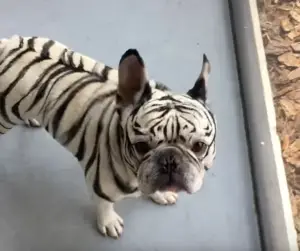There are different types of Frenchies, and while we love all of them equally, it’s important that we know the differences between some of them. Blue and lilac Frenchies may look similar, but there’s some key differences.
The thing is, many of these differences can often be rather subtle, so it can be a bit tricky to know the differences between the two Frenchies. Luckily for you though, we’ve composed this handy guide.
We’ll show you the differences between these two adorable types of Frenchies along with some excellent helpful tips. So, if you’re looking to know more – read on!
Lilac French Bulldogs
One of the most striking points to notice with a lilac French bulldog is the very obvious lilac hue that they have on their furry coat.
This is actually caused by a dilution in their genes which leads to a hue of blue hair. Some people might argue about this color that it is actually more of a pale gray tint, but it’s actually a unique color.
This type of Frenchie is a carrier of the recessive gene, so it will happen with all of the Frenchie’s puppies too!
Speaking of their puppies, when a lilac French bulldog is born, their coats come across much like a blue French bulldog, but the differences start to arise when the Frenchie matures and gets older.
As the Frenchie matures, their coat changes its coloration and becomes much lighter which brings a very distinct lilac tint. Another noticeable difference is their eyes.
The eyes of a lilac French bulldog can be either amber, blue or even a gray color. It’s difficult to guess what their eye color will actually be before they are born, but you can make an educated guess depending on their genes.
Their noses are usually gray to brown or they can be pink, and they can even be a mix of the two with pale pink markings that surround their eyes and mouth.
To avoid health problems with these specific French bulldogs, their breeding needs to be carefully conducted and as a result of this, if you went to purchase a lilac French bulldog, you’d probably notice that the price is very high.
This is only because the costs of the breeding are higher, so they need to pass the bill on to the buyer.
Blue French Bulldog
Now we will take a look at the blue French bulldog. Their genes play the most important role for their distinctive color!
There are many myths that surround blue French bulldogs. Notably, people have said in the past that blue Frenchies have major health problems when they mature and develop. However, this is not always the case.
If you source a blue French bulldog from a very reputable breeder, you will find their health to be immaculate and you should not notice major conditions when they get older.
The largest misconception likely comes from the fact that some breeds of blue Frenchie develop a condition known as CPA which is color dilution alopecia. This is however, normally as a result of a fault in their genes of that specific dog.
Blue Frenchies have a beautiful coat and often have a white mark on their chest. Their eyes are usually a gray or hazel color, but some have been known to have blue eyes too.
Their ears are often described as bat-like due to their shape, but it’s important to note that their ears can drop and move depending on their mood and if they have any pre-existing conditions.
If a blue Frenchie is born, it can be difficult to determine if it is actually a blue French bulldog or not. However, many breeders and other experts have said that there is one way that you should be able to tell.
In order to differentiate this type of Frenchie from the lilac Frenchie when they are born is through the nose. Blue French bulldogs usually have a blue tint or hue on their noses when they are puppies.
While blue French bulldogs are very similar to lilac Frenchies, the way in which they are looked after by the breeders does not change largely, meaning the price is once again going to be relatively high.
This is because the breeder pays for a specific diet, grooming, supplements and housing – so be prepared for the price before you buy!
Final Thoughts
These two types of French bulldog are beautiful in their own ways but they of course have distinct differences which are important to understand.
We hope this guide was helpful for you to recognize the differences!




